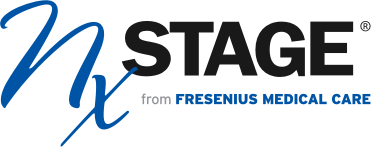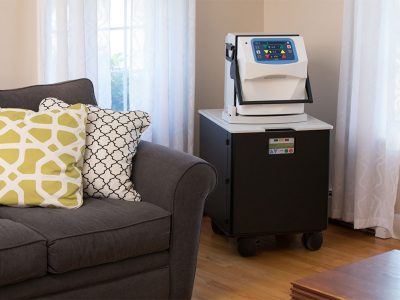Home nocturnal hemodialysis is designed as a simple and practical extended therapy option for patients.
Duration matters, even with more frequent therapy
Improved survival
- Performing more frequent nocturnal hemodialysis has shown similar 5-year survivability rates as deceased donor transplantation.1
Better cardiovascular outcomes
- Regional Wall Motion Abnormalities (RWMAs) are associated with cardiac stunning and elevated mortality risk. Patients performing more frequent hemodialysis with lower Ultrafiltration (UF) rates resulted in a mean reduction of RWMAs as compared to conventional, thrice-weekly therapy with higher UF rates.2
Improved phosphorus control and middle molecule clearance
- Compared to conventional thrice-weekly in-center hemodialysis, nocturnal hemodialysis is associated with improved control of hyperphosphatemia, in addition to significantly higher total cleared volume both in Phosphorus and β2 microglobulin.3,4
Improved energy and vitality
- More frequent dialysis, during the day or overnight, may provide significant and wide-reaching therapeutic benefits.
- Quicker time to recovery5,6
- Less dietary restriction7
- Better blood pressure control with fewer medications8,9
References:
- Pauly RP, Gill JS, Rose CL, et al. Survival among nocturnal home haemodialysis patients compared to kidney transplant recipients. Nephrol Dial Transplant. 2009;24:2915-2919.
- Jefferies et.al. Frequent hemodialysis schedules are associated with reduced levels of dialysis-induced cardiac injury (Myocardial stunning). Clin J Am Soc Neprhol. 2011;6(6):1326-1332.
- Raj DS, Ouwendyk M, Francoeur R, Pierratos A. ß2-Microglobulin kinetics in nocturnal haemodialysis. Nephrol Dial Transplant. 2000;15(1):58-64.
- Daugirdas JT, Chertow GM, Larive B, et al. Effects of frequent hemodialysis on measures of CKD mineral and bone disorder. J Am Soc Nephrol. 2012;23:727-738.
- Jaber BL, Lee Y, Collins AJ, et al. Effect of daily hemodialysis on depressive symptoms and postdialysis recovery time: interim report from the FREEDOM (Following Rehabilitation, Economics and Everyday-Dialysis Outcome Measurements) Study. Am J Kidney Dis. 2010;56(3):531-539.
- Lindsay RM, Heidenheim PA, Nesrallah G, Garg AX, Suri R, Daily Hemodialysis Study Group London Health Sciences Centre. Minutes to recovery after a hemodialysis session: a simple health-related quality of life question that is reliable, valid, and sensitive to change. Clin J Am Soc Nephrol. 2006;1(5):952-959.
- Spanner E, Suri R, Heidenheim AP, Lindsay RM. The impact of quotidian hemodialysis on nutrition. Am J Kidney Dis. 2003;42(1 suppl):30-35.
- Jaber BL, Collins AJ, Finkelstein FO, et al. Daily hemodialysis (DHD) reduces the need for antihypertensive medications. Abstract presented at American Society of Nephrology Conference, October 29, 2009.
- Kotanko P, Garg AX, Depner T, et al. Effects of frequent hemodialysis on blood pressure: Results from the randomized frequent hemodialysis network trials. Hemo Int. 2015;19(3):386-401.
Risks and Responsibilities
The reported benefits of home hemodialysis (HHD) may not be experienced by all patients.
The NxStage System is a prescription device and, like all medical devices, involves some risks. The risks associated with hemodialysis treatments in any environment include, but are not limited to, high blood pressure, fluid overload, low blood pressure, heart-related issues, and vascular access complications. When vascular access is exposed to more frequent use, infection of the site, and other access related complications may also be potential risks. The medical devices used in hemodialysis therapies may add additional risks including air entering the bloodstream, and blood loss due to clotting or accidental disconnection of the blood tubing set.
Home hemodialysis with the NxStage System during waking hours may not require a care partner, provided a physician and a qualified patient agree that solo home hemodialysis is appropriate. Patients performing nocturnal treatments are required to have a care partner. Care partners are trained on proper operation and how to get medical or technical help if needed.
Certain risks associated with hemodialysis treatment are increased when performing solo HHD because no one is present to help the patient respond to health emergencies. If patients experience needles coming out, blood loss, or very low blood pressure during solo HHD, they may lose consciousness or become physically unable to correct the health emergency. Losing consciousness or otherwise becoming impaired during any health emergency while alone could result in significant injury or death. Additional ancillary devices and training are required when performing solo HHD.
Certain risks associated with hemodialysis treatment are increased when performing nocturnal therapy due to the length of treatment time and because therapy is performed while the patient and care partner are sleeping. These risks include, but are not limited to, blood access disconnects and blood loss during sleep, blood clotting due to slower blood flow and/or increased treatment time, and delayed response to alarms when waking from sleep.
Patients should consult their doctor to understand the risks and responsibilities of performing these therapies using the NxStage System.









